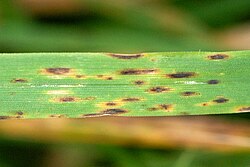Top Qs
Timeline
Chat
Perspective
Pleosporaceae
Family of fungi From Wikipedia, the free encyclopedia
Remove ads
Pleosporaceae is a family of sac fungi. They are pathogenic to humans or saprobic on woody and dead herbaceous stems or leaves.[2]
They are generally anamorphic species (having an asexual reproductive stage).[3] The type species is Stemphylium botryosum Wallr.[2]
They have a cosmopolitan distribution worldwide.[4]
Remove ads
History
Summarize
Perspective
The family was created in 1869,[1] based on the immersed ascomata and pseudoparaphyses of some species, and it was assigned to Sphaeriales order. It was then placed in the Pseudosphaeriaceae family by Theissen & Sydow (1917a) and then later raised to ordinal rank as the Pseudosphaeriales.[5] Luttrell (1955) assigned Pleosporaceae under the Pleosporales order and treated Pseudosphaeriales as a synonym of Pleosporales.[6] Later, availability of molecular data, and multi-gene phylogenetic studies confirmed the familial placement of Pleosporaceae with respect to other families in order Pleosporales (Lumbsch & Huhndorf 2010,[7] Zhang et al. 2012b).[8] Genera Alternaria, Bipolaris and Stemphylium are more common asexual morphs in Pleosporaceae and they are also saprobes or parasites on various hosts.[2] Boonmee et al. transferred Allonecte from family Tubeufiaceae to family Pleosporaceae in 2011.[9] Ariyawansa et al. (2015c) revised the family and accepted 18 genera into it.[10] According to Wijayawardene et al. (2018),[11] 16 genera were accepted in Pleosporaceae based on morphological and molecular data. Pem et al. (2019c) accepted genus Gibbago in Pleosporaceae based on morphological and molecular data.[12]
Remove ads
Genera
Summarize
Perspective
As accepted by Wijayawardene et al. 2020;[13]
- Allonecte Syd. (3)
- Alternaria Nees ex Wallroth, 1816 (360)
- Bipolaris Shoemaker (179)
- Chalastospora E.G.Simmons, 2007 (2)
- Clathrospora Rabenh. (20)
- Cochliobolus Drechsler, 1934 (19)
- Comoclathris Clem.(30)
- Curvularia Boedijn (497)
- Decorospora (Pat.) Inderbitzin, Kohlm. & Volkm.-Kohlm, 2002 (3)
- Diademosa Shoemaker & C.E. Babc. (4)
- Dichotomophthora Mehrl. & Fitzp. ex M.B.Ellis, 1971 (6)
- Drechslera S.Ito, 1930 (36)
- Embellisia E.G.Simmons, 1971 (3)
- Exserohilum K.J. Leonard & Suggs (113)
- Extrawettsteinina M.E. Barr (2)
- Gibbago E.G.Simmons, 1986 (2)
- Johnalcornia Y.P.Tan & R.G.Shivas, 2014 (4)
- Lewia M.E. Barr & E.G. Simmons
- Macrospora Fuckel (2)
- Macrosporium Fries, 1832 (13)
- Malustela (1)
- Mycoporopsis Müll.Arg. (12)
- Paradendryphiella Woudenb. & Crous, 2013 (2)
- Paraliomyces Kohlmeyer, 1959 (2)
- Platysporoides (Wehm.) Shoemaker & C.E. Babc. (12)
- Pleoseptum A.W. Ramaley & M.E. Barr (1)
- Pleospora Rabenh. ex Ces. & De Not., 1863 (458)
- Porocercospora Amaradasa, Amundsen, H.Madrid & Crous, 2014 (12)
- Pseudoyuconia Lar. N. Vailjeva (1)
- Prathoda Subram. (2)
- Pseudoyuconia Lar.N. Vassiljeva (1)
- Pyrenophora Fr., 1849 (133)
- Scleroplea (1)
- Stemphylium Wallroth, 1833 (96)
- Tamaricicola Thambug., Camporesi & K.D. Hyde (1)
- Teretispora E.G.Simmons (2)
- Typhicola Crous, 2019 (2)
Figures in brackets are approx. how many species per genus.[13]
Remove ads
References
External links
Wikiwand - on
Seamless Wikipedia browsing. On steroids.
Remove ads

